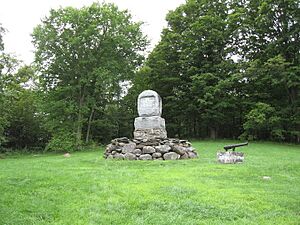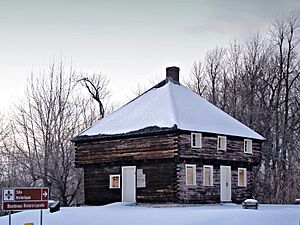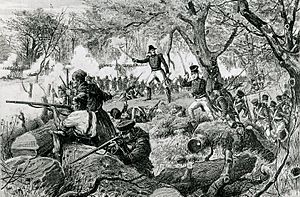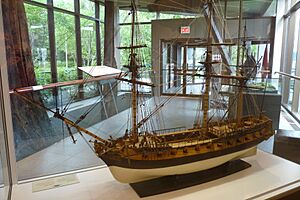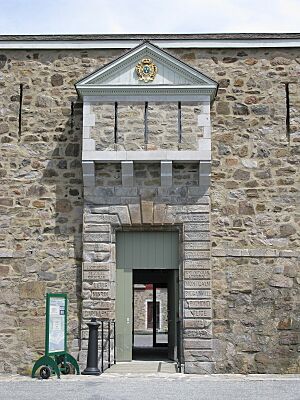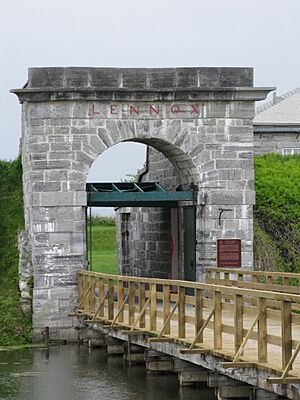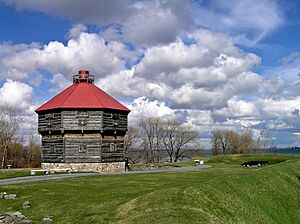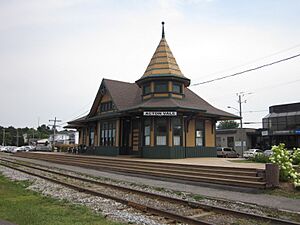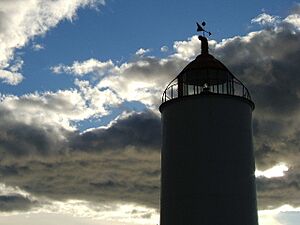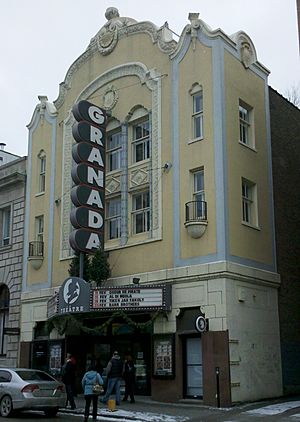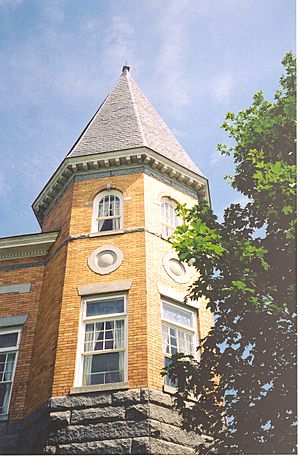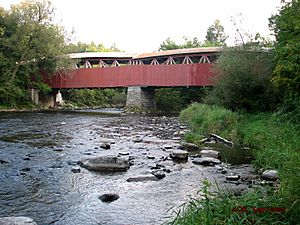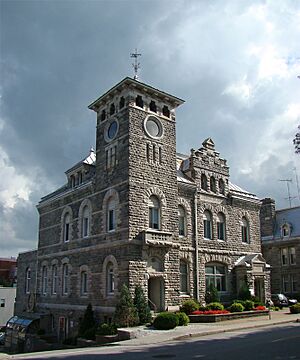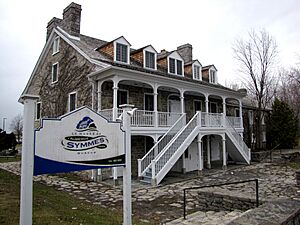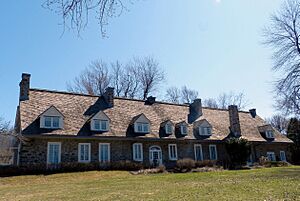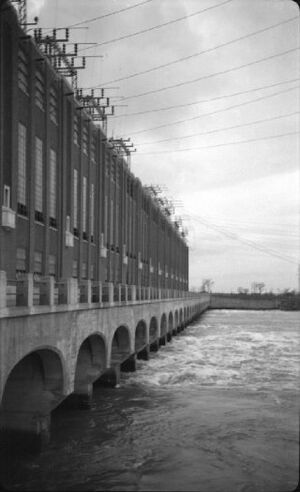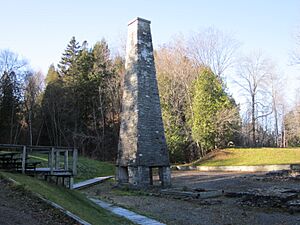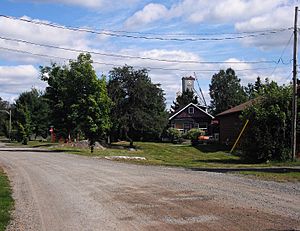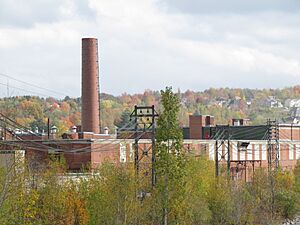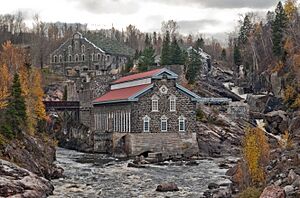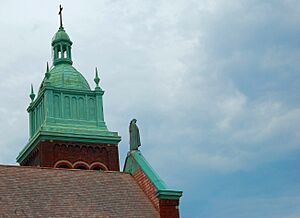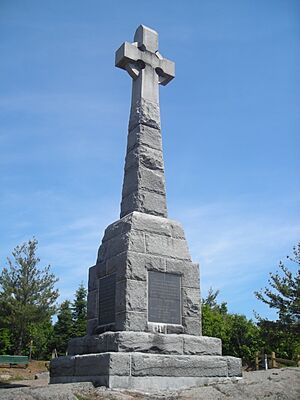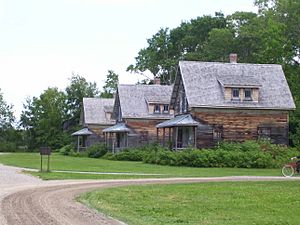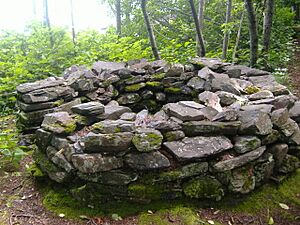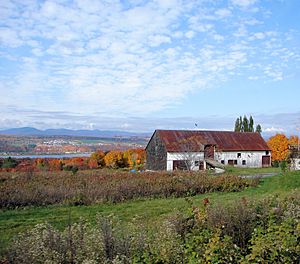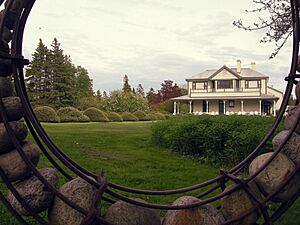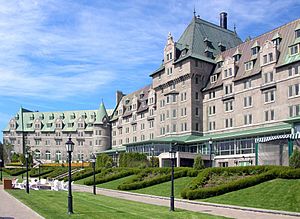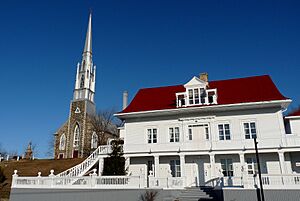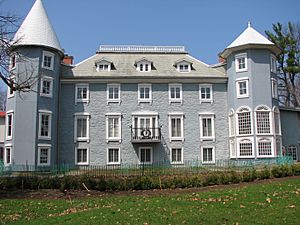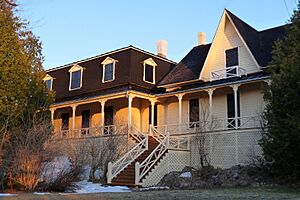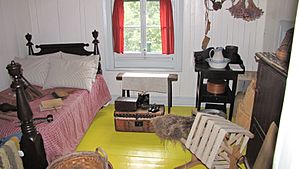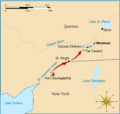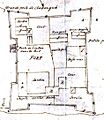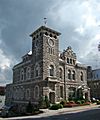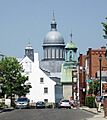List of National Historic Sites of Canada in Quebec facts for kids
Quebec is home to many amazing places called National Historic Sites. These are special spots that tell important stories about Canada's past. As of 2019, there were 198 of these sites in Quebec! Thirty of them are looked after by Parks Canada (you'll see a beaver icon ![]() next to these).
next to these).
You can find separate lists for sites in Montreal and Quebec City. Besides sites, many important historical events and famous people are also remembered across Quebec with special markers. These markers don't always say if it's a site, event, or person being honored. The names used here are the official ones from the national Historic Sites and Monuments Board.
Contents
Exploring Quebec's Historic Treasures
Quebec's National Historic Sites cover a huge range of history, from ancient times to more recent events. They help us understand how Canada grew and changed.
Battles and Forts: Echoes of the Past
Many sites in Quebec mark important battles and forts that shaped the country.
- Battle of Eccles Hill (Designated 1923): Near Frelighsburg, this site remembers a battle in 1870 where Canadian volunteers stopped invaders.
- Battle of Lacolle (Designated 1923): In Notre-Dame-du-Mont-Carmel, a small group of British and Canadian defenders fought off an American attack in 1814. This was the last American invasion of Lower Canada during the War of 1812.
- Battle of the Chateauguay
 (Designated 1920): Near Ormstown, in 1813, a smaller force of French Canadian soldiers and Mohawk warriors, led by Charles de Salaberry, bravely stopped a much larger American army from invading.
(Designated 1920): Near Ormstown, in 1813, a smaller force of French Canadian soldiers and Mohawk warriors, led by Charles de Salaberry, bravely stopped a much larger American army from invading.
- Battle of the Restigouche
 (Designated 1924): This naval battle took place in 1760 on the Restigouche River near Pointe-à-la-Croix. It was the last naval battle of the Seven Years' War in North America, and the French loss helped lead to the fall of New France.
(Designated 1924): This naval battle took place in 1760 on the Restigouche River near Pointe-à-la-Croix. It was the last naval battle of the Seven Years' War in North America, and the French loss helped lead to the fall of New France.
- Fort Chambly
 (Designated 1920): This stone fortress on the Richelieu River in Chambly was built in 1665. It was used by both the French and British during many conflicts, including the Seven Years' War and the War of 1812.
(Designated 1920): This stone fortress on the Richelieu River in Chambly was built in 1665. It was used by both the French and British during many conflicts, including the Seven Years' War and the War of 1812.
- Fort Lennox
 (Designated 1920): Located on Île aux Noix in the Richelieu River, this fort was a key entry point into Canada. It was used by French, British, and American forces over the years.
(Designated 1920): Located on Île aux Noix in the Richelieu River, this fort was a key entry point into Canada. It was used by French, British, and American forces over the years.
- Coteau-du-Lac
 (Designated 1923): In Coteau-du-Lac, you can see the remains of an old canal and military forts. This site has one of the oldest lock canals in North America and played a strategic role during the War of 1812.
(Designated 1923): In Coteau-du-Lac, you can see the remains of an old canal and military forts. This site has one of the oldest lock canals in North America and played a strategic role during the War of 1812.
- Lévis Forts
 (Designated 1920): Near Lévis, these are the remains of three 19th-century stone forts. Built by the British, they were an important part of Quebec City's defenses.
(Designated 1920): Near Lévis, these are the remains of three 19th-century stone forts. Built by the British, they were an important part of Quebec City's defenses.
Amazing Old Buildings and Structures
Quebec has many beautiful and important buildings that tell stories of daily life and special events.
- Acton Vale Railway Station (Grand Trunk) (Designated 1976): This small passenger station in Acton Vale, built in 1900, shows how the Grand Trunk Railway expanded across Canada.
- Cap-des-Rosiers Lighthouse (Designated 1973): Completed in 1858 in Gaspé, this 37-meter high stone lighthouse is the tallest in Canada. It helped guide ships safely.
- Île-Verte Lighthouse (Designated 1974): This 12-meter high stone lighthouse in Notre-Dame-des-Sept-Douleurs was completed in 1809. It was the very first lighthouse on the Saint Lawrence River and is the third oldest in Canada.
- Granada Theatre (Designated 1996): In Sherbrooke, this theatre, completed in 1929, has a unique Spanish Revival style. It's a great example of an "atmospheric theatre" in Canada, designed to make you feel like you're in a different place.
- Haskell Free Library and Opera House (Designated 1985): This two-story building in Stanstead, completed in 1904, is truly special. It houses both a library and an opera house, and it sits right on the border between Canada and the United States! It was given to people in both countries.
- Moulin Légaré (Designated 1999): In Saint-Eustache, this flour mill has been working continuously since the French colonial period (completed 1763). It shows how important mills were in the early farming economy of Quebec.
- Pointe-du-Moulin Windmill (Designated 1969): This very rare stone windmill and the miller's house in Notre-Dame-de-l'Île-Perrot date back to the 18th century. It's a great example of early Quebec architecture.
- Powerscourt Covered Bridge (Designated 1984): This wooden covered bridge in Elgin and Hinchinbrooke, built in 1861, still stands on its original stone foundations. It's the only remaining "McCallum inflexible arched truss bridge" in the world and one of Canada's oldest covered bridges.
- Saint-Hyacinthe Post Office (Designated 1983): Completed in 1894, this post office in Saint-Hyacinthe is a notable example of the work of famous federal architect Thomas Fuller.
- Symmes Hotel (Designated 1976): This stone inn in Gatineau, built in 1831, overlooks the Ottawa River. It was an important stopping place on an early transportation route that led to trading posts in northwestern Quebec.
- Maison Trestler (Designated 1969): In Vaudreuil-Dorion, this stone house, completed in 1806, is a great example of traditional Quebec architecture.
- Sainte-Croix-de-Tadoussac Mission Church (Designated 2012): Completed in 1750 in Tadoussac, this is the oldest wooden church still standing in Canada. It shows the work of missionaries in remote areas of New France.
Places of Innovation and Industry
These sites highlight Quebec's role in Canada's industrial and economic development.
- Beauharnois Power Development (Designated 1990): This huge hydroelectric power plant on the Saint Lawrence River in Beauharnois was very important for the economy and technology when it was built in 1930.
- Forges du Saint-Maurice
 (Designated 1919): In Trois-Rivières, this was an industrial area where an ironworks operated for over 150 years, starting in 1730. It marked the beginning of Canada's iron industry.
(Designated 1919): In Trois-Rivières, this was an industrial area where an ironworks operated for over 150 years, starting in 1730. It marked the beginning of Canada's iron industry.
- Former Lamaque Mine and the Bourlamaque Mining Village (Designated 2012): Located in Val-d’Or, this site includes a former gold mine and a nearby planned mining town. It's a well-preserved example of a mining landscape and a "company town" (a town built by a company for its workers).
- Former Shawinigan Aluminum Smelting Complex (Designated 2002): In Shawinigan, this complex, established in 1899, was one of the earliest aluminum smelters in North America. It had its own hydroelectric facilities to power it.
- Magog Textile Mill (Designated 1989): This mill in Magog, completed in 1883, was the only 19th-century cotton mill in Canada where all steps of cotton processing (spinning, weaving, bleaching, and printing) happened in one place.
- Old Chicoutimi Pulp Mill (Designated 1983): This industrial complex in Chicoutimi, with stone buildings from 1898 to 1923, was the biggest producer of mechanical wood pulp in Canada in the early 20th century.
- Saint-Joseph-de-la-Rive Shipyard (Designated 1996): This shipyard in Les Éboulements, established in 1946, was known for building wooden schooners called "goélettes" for coastal shipping along the Saint Lawrence River.
Unique Cultural and Social Sites
These sites offer a glimpse into the diverse cultures and social history of Quebec.
- Apitipik (Designated 1996): Near Gallichan, this area has been a traditional summering and sacred place for the Abitibiwinni for thousands of years. It was also a site for trading posts from 1686 to 1922.
- Arvida Historic District (Designated 2012): Established in 1925, Arvida is a well-preserved example of a "company town" that shows urban planning ideas like the City Beautiful and Garden city movements. It's also a symbol of Canada's growing aluminum industry.
- Banc de Pêche de Paspébiac (Designated 2001): In Paspébiac, this site has ten buildings on a large sandbar. It's connected to the commercial cod fishing industry in the Gulf of Saint Lawrence, which started here in 1783.
- Blanc-Sablon (Designated 2007): This area has over 60 archaeological sites that show 9,000 years of human life, including ancient Indigenous cultures and early European periods.
- Grosse Île and the Irish Memorial
 (Designated 1974): This island near Saint-Antoine-de-l'Isle-aux-Grues was a quarantine station for immigrants arriving in Quebec City from 1832 to 1937. It's a reminder of the importance of immigration and the sad experiences of Irish immigrants during the typhus epidemic of 1847.
(Designated 1974): This island near Saint-Antoine-de-l'Isle-aux-Grues was a quarantine station for immigrants arriving in Quebec City from 1832 to 1937. It's a reminder of the importance of immigration and the sad experiences of Irish immigrants during the typhus epidemic of 1847.
- The Historic Village of Val-Jalbert, Chambord, Quebec (Designated 2019): Founded in 1901 in Chambord, this was a pulp mill company town. It's now a ghost town and park, showing what life was like in a company town.
- Île aux Basques (Designated 1984): This small island near Trois-Pistoles was an outpost for Basque fishermen from France around 1580 to 1630. It's the only place in the Gulf of Saint Lawrence where we have archaeological proof of early trade between Europeans and Indigenous peoples.
- Île d'Orléans Seigneury (Designated 1990): Established in 1636, this was one of the first settled areas of New France. The landscape and old buildings from the 17th and 18th centuries show what the seigneurial system of New France (a way of dividing land) was like.
- Jardins de Métis (Designated 1995): In Grand-Métis, these beautiful gardens were created by Elsie Reford between 1926 and 1958. They are an excellent example of an English-inspired garden in Canada.
- La Malbaie Historic District (Designated 2007): This is one of Canada's oldest "villégiature," or vacation, areas. It has amazing views of the Saint Lawrence River.
- La Petite-Ferme du cap Tourmente (Designated 2018): This farm in Saint-Joachim was started by Champlain in 1626, making it the first farm in the St. Lawrence Valley. It was used for 300 years and is now part of the Cap Tourmente National Wildlife Area.
- Pointe-du-Buisson (Designated 2005): This 21-hectare archaeological site in Beauharnois shows the history of Indigenous peoples over the last 5,000 years who used the Saint Lawrence River for travel.
- Waapushukamikw (Designated 2009): This white quartzite hill in Baie-James was a major quarry site for Indigenous peoples and is still a special spiritual place for the Mistissini Cree.
Homes of Famous Canadians
Several sites are recognized for their connection to important figures in Canadian history.
- Chapais House (Designated 1962): This house in Saint-Denis-De La Bouteillerie, built in 1834, was the home of Jean Charles Chapais, one of the Fathers of Confederation (people who helped create Canada).
- de Salaberry House (Designated 1968): In Chambly, this large stone house, built in 1815, was the home of Charles de Salaberry, the hero of the Battle of Chateauguay.
- Étienne-Paschal Taché House (Designated 1990): This unique house with twin towers in Montmagny, completed in 1830, was the home of Sir Étienne-Paschal Taché, another Father of Confederation.
- Louis S. St. Laurent
 (Designated 1973): This site in Compton is where Canada's 12th Prime Minister, Louis St. Laurent, was born. It also tells the story of the Eastern Townships region.
(Designated 1973): This site in Compton is where Canada's 12th Prime Minister, Louis St. Laurent, was born. It also tells the story of the Eastern Townships region. - Manoir Papineau
 (Designated 1986): This large mansion in Montebello, completed in 1850, overlooks the Ottawa River. It honors its first owner, Louis-Joseph Papineau, a key political figure in Quebec.
(Designated 1986): This large mansion in Montebello, completed in 1850, overlooks the Ottawa River. It honors its first owner, Louis-Joseph Papineau, a key political figure in Quebec.
- Sir John A. Macdonald’s Summer Residence (Designated 2014): In Rivière-du-Loup, this house, completed in 1880, was the summer home of Canada's first Prime Minister, John A. Macdonald.
- Sir Wilfrid Laurier
 (Designated 1938): This small house in Saint-Lin-Laurentides commemorates Wilfrid Laurier, Canada's 7th Prime Minister, who was born nearby in 1841.
(Designated 1938): This small house in Saint-Lin-Laurentides commemorates Wilfrid Laurier, Canada's 7th Prime Minister, who was born nearby in 1841.
- Wilfrid Laurier House (Designated 1999): This red-brick house in Victoriaville, completed in 1877, was Wilfrid Laurier's main home for 20 years and his summer home until he passed away in 1919. It's now a museum.
Images for kids
See also
- Cultural heritage of Quebec
- History of Quebec
- Répertoire du patrimoine culturel du Québec


